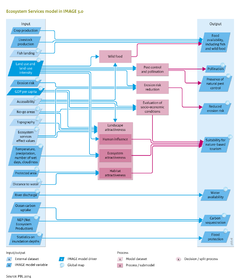Ecosystem services/Description: Difference between revisions
Jump to navigation
Jump to search
Oostenrijr (talk | contribs) No edit summary |
Oostenrijr (talk | contribs) No edit summary |
||
| Line 7: | Line 7: | ||
The supply of ecosystem services can be evaluated and aggregated in several ways. Some studies have constructed hotspot maps based on the number of services delivered ([[Egoh et al., 2008]]; [[Egoh et al., 2009]]; [[O'Farrell et al., 2010]]). Others translate service provision into monetary values for ecosystems ([[Costanza et al., 1997]]; [[TEEB, 2010b]]; [[UNEP-WCMC, 2011]]). | The supply of ecosystem services can be evaluated and aggregated in several ways. Some studies have constructed hotspot maps based on the number of services delivered ([[Egoh et al., 2008]]; [[Egoh et al., 2009]]; [[O'Farrell et al., 2010]]). Others translate service provision into monetary values for ecosystems ([[Costanza et al., 1997]]; [[TEEB, 2010b]]; [[UNEP-WCMC, 2011]]). | ||
The main shortcoming of hotspot maps and monetising is the lack of information whether sufficient ecosystem services are delivered to fulfil human requirements ([[Burkhard et al., 2012]]). Here, the service supply is compared to the potential requirement (minimum quantity required by humans) in order to assess surpluses and deficiencies. This translates into minimum quantities of food and water to stay healthy, or the minimum quantity of natural elements in a landscape to potentially pollinate all crops. The relation between supply and potential requirement is the ecosystem services budget. These budgets are relevant at different spatial scales, because some services can only be provided locally, while others (mainly goods) can be transported longer distances. The most relevant assessment scale for each ecosystem service was determined given the underlying modelling approaches ( | The main shortcoming of hotspot maps and monetising is the lack of information whether sufficient ecosystem services are delivered to fulfil human requirements ([[Burkhard et al., 2012]]). Here, the service supply is compared to the potential requirement (minimum quantity required by humans) in order to assess surpluses and deficiencies. This translates into minimum quantities of food and water to stay healthy, or the minimum quantity of natural elements in a landscape to potentially pollinate all crops. The relation between supply and potential requirement is the ecosystem services budget. These budgets are relevant at different spatial scales, because some services can only be provided locally, while others (mainly goods) can be transported longer distances. The most relevant assessment scale for each ecosystem service was determined given the underlying modelling approaches (the table below). | ||
<div class="thumbcaption dark">Table: Assessment scale for each ecosystem service analysed</div> | <div class="thumbcaption dark">Table: Assessment scale for each ecosystem service analysed</div> | ||
Revision as of 12:56, 24 June 2014
Parts of Ecosystem services/Description
